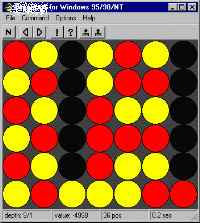A Brief Introduction to 4 in a row
4 in a row is a rather simple board game. At least the rules are simple. But how about the game? 4 in a row is solved, i.e. the game has been calculated from start to end by computer and it has been proven that the player to start can always win. However only if she puts the first stone in the central column. For humans, 4 in a row remains a challenge. This tutorial is supposed to give you some ideas on how to play if you want to win. To begin, let me state the obvious - if you want to get four stones in a row, you must first have 3 of your stones in the row (or diagonal). And before you have 3 stones in a 4-row, you must first have 2 there. And before...

Figure 2: Yellow to play and win
Figure 2 shows a very simple win for yellow. He can either play b1 or e1, creating either the threat to get 4 in a row with a1 or e1 or, in the case of e1, to get 4 in a row by playing b1 or f1. Red can obviously not stop both threats at once and loses. Most tactical possibilities are similar to this, but a bit more complicated.
Figure 3: Yellow to play and win
Figure 3 also shows a simple win for yellow: by playing e3 he creates the threat f3, forcing red to answer f3, but then yellow plays f4 and gets 4 in a row in the diagonal.
Figure 4: Yellow to play and win
Figure 4 shows a more complicated forced win for yellow. By combining immediate threats, he wins: d5 forces red to play d6, then f3 forces red to play f4, and e3 forces red to play g1. Note that a different move order would also work in this example. Now yellow plays e4, leading to figure 5.
Figure 5: Red to play
In figure 5 yellow has created a vertical double threat by the forced sequence from figure 4: yellow could win by either taking g2 or g3. Such a constellation always wins immediately (of course only in the absence of direct threats of the other side). Red has to put a stone on g2, but then yellow wins with g3. A vertical double threat wins because the side which owns the threat can just start filling in the column, until he threatens to win with the lower of the two threats, and the other side cannot stop him because stopping the first threat will allow the second one to be executed.
Figure 6: Yellow to play
We have seen that one threat for yellow on an even row won't win. How about two? This situation is shown in figure 6. Yellow has created two even threats on the second row. However, this also doesn't help him. Once the remaining 5 columns are filled, yellow has to play in column b or f, losing his threat there. He keeps one even threat - which leads to a draw.
Figure 7: Yellow to play
Two even threats for yellow don't win - so how about two odd threats for red? In figure 7, red has created two odd threats - and he's winning! All other columns have been filled, and yellow has dropped one stone in column c, to which red responded with g1. Now yellow has to drop a stone and will lose. Again, we see that 4 in a row is an asymmetric game. Having two "wrong" threats is wrong for yellow, but right for red. It's easy to understand: If there is a threat on an odd row, it effectively changes the role of red and yellow, because an odd number of stones can still be dropped in that column. Therefore, if red has one threat in an odd row, he can win by creating another threat in an odd row. Of course, he can also win by creating a threat in an even row and giving up the threat in the odd row.Further Reading
James D Allen has written an article on expert play in 4 in a row. It explores the above ideas in (much!) more depth and with more Japanese words ;-) - it also gives you a list of the winning openings. Allen was one of the first two persons to solve 4 in a row. The other was Victor Allis. Velena is a DOS program which plays perfectly.Written in march 2000 by Martin Fierz, 4inarow(a)fierz.ch. Comments on this tutorial are welcome!